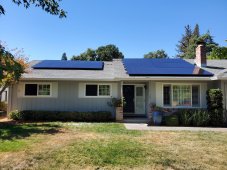Ampster
Renewable Energy Hobbyist
We recently purchased a new home in Kenwood CA and the first priority was putting solar on the roof. My house faces Southeast with ocassional shading from some trees and a chimney. I was fortunate to find a local resource that connected me to someone who would draw a set of plans to submit to Sonoma County. We settled on a 7.9 kW system since that was the maximum we could fit on that face of the roof. I found a reasonable price on Mission 345 Watt panels from EcoDirect. Conveniently they had a supplier with a nearby warehouse. The balance of the system I purchased from CED Greentech. We used IronRidge SR1000 rails and their standoffs.
My permit from Sonoma County includes a new main service panel and two subpanels. One of those subpanels will become my essenial loads panel when I reinstall the Outback Skybox I removed from our prior home. The main service panel is a 100 Amp Zinsco panel that is a known fire hazard. Initially I had planned on a new 200 Amp service panel but susequently decided a like for like replacement would be more expedient after consulting my electrician. A like for like replacement allows me to use a 125 Amp service panel in the same location as the original Zinsco. A rule from PG&E would have required me to locate an upgraded panel 36 inches away from an existing natural gas riser. That would have required a new service drop and possibly a transformer upgrade. Those were expenses and delay causing contingencies which I wanted to avoid.
The panel installation was completed yesterday and I am still waiting for PG&E to pick a date for my electician to do the service panel swap out. I have already wired the two subpanels.
My permit from Sonoma County includes a new main service panel and two subpanels. One of those subpanels will become my essenial loads panel when I reinstall the Outback Skybox I removed from our prior home. The main service panel is a 100 Amp Zinsco panel that is a known fire hazard. Initially I had planned on a new 200 Amp service panel but susequently decided a like for like replacement would be more expedient after consulting my electrician. A like for like replacement allows me to use a 125 Amp service panel in the same location as the original Zinsco. A rule from PG&E would have required me to locate an upgraded panel 36 inches away from an existing natural gas riser. That would have required a new service drop and possibly a transformer upgrade. Those were expenses and delay causing contingencies which I wanted to avoid.
The panel installation was completed yesterday and I am still waiting for PG&E to pick a date for my electician to do the service panel swap out. I have already wired the two subpanels.



